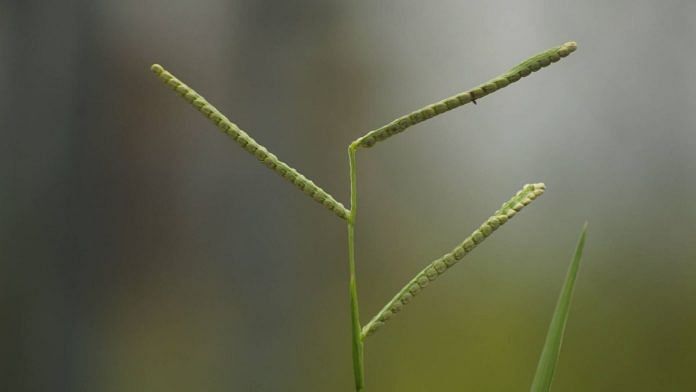New Delhi: On 31 October, the first explanation emerged for the mysterious deaths of 10 elephants in Madhya Pradesh’s Bandhavgarh Tiger Reserve. Though veterinarians are waiting for the post-mortem reports, forest officials said chances are the cause of death was kodo poisoning.
Principal Chief Conservator of Forests (Wildlife) Vijay N. Ambade said in a statement that the deaths could have been caused by “mycotoxins associated with kodo millet”.
ThePrint explains what kodo poisoning is and how it could be responsible for the tusker deaths in Bandhavgarh.
Crop native to Central India
Kodo millet (Paspalum scrobiculatum), also known as cow grass or rice grass, is a type of cereal grain that is grown and eaten extensively across Central India, especially the Deccan Plateau. According to the Agricultural and Processed Food Products Export Authority (APEDA), it is rich in fibre and can help in the management of a variety of ailments, including asthma, migraines, and high blood pressure.
A 2017 report by the Indian Institute of Millets Research said that kodo millets are grown in 1.96 lakh hectares of land in the country, mainly in the states of Madhya Pradesh, Andhra Pradesh, Rajasthan, Uttar Pradesh, and Tamil Nadu. It is one of the oldest crops in India, having been domesticated 3,000 years ago.
It also grows in parts of Africa and is eaten during famines because it is a sturdy, drought-resistant crop. The 1996 book ‘Lost Crops of Africa’, published by the US National Academies of Sciences, Engineering, and Medicine (NASEM), said the kodo millet is a “lifesaver for subsistence farming families”.
However, one of the main problems with the crop, it says, is that it is prone to an “ergot-like fungal disease”, especially when it is harvested around monsoons. The damp conditions caused by rainfall and high humidity levels during the season can cause multiple types of toxic fungi to infest the crop.
Studies conducted by Indian academics, too, warned of kodo poisoning—when humans or animals consume the millet infested with Aspergillus tamarii Kita. This fungus contains mycotoxins (toxins produced by fungus) that cause everything from allergic reactions and liver diseases to immune problems, and, even, cancer.
Infected crops can be harmful to humans, animals
Kodo poisoning in animals has been recorded in the past as well. A 2003 paper published in the Journal of Ethnopharmacology, a peer-reviewed medical journal, studied its effects on rats, dogs, and chickens who consumed the fungus-infested crop.
According to the paper, the crop is “frequently infested with this fungus”. The presence of cyclopiazonic acid—a type of mycotoxin—lead to acute hepatotoxicity in rats causing serious liver damage. It affected the kidneys and gastrointestinal tracts of dogs and caused lesions and weight gain in chickens. In essence, it concluded that exposure to fungus-infested kodo millets can be extremely harmful to both humans and animals.
A 2020 study in The Pharma Innovation Journal noted that a cattle herd in Chhattisgarh’s Durg district exposed to kodo millets infested with Claviceps fungi, which also produces mycotoxins, experienced convulsions, dizziness, limb contractions, and even death in some cases.
ThePrint had reported on 31 October that the preliminary findings of autopsy done on one of the dead Asian elephants in Bandhavgarh showed the presence of “a large amount of Kodo inside the stomach”. The samples from the elephant’s stomach and from the fields where they had grazed have been sent to labs to be tested, to confirm whether it was indeed kodo poisoning that killed the elephants.
While there haven’t been studies specifically looking at elephants being poisoned by kodo millets, Ambade, had previously told ThePrint that there has been at least one prior incident of kodo poisoning that killed an elephant in 2022. Also, farmers that had left their fungus-infested kodo crops out in the open will now be persuaded to burn them to prevent other elephants or animals from eating them, he added.
“It is well known that fungal-infected millet grain can produce a variety of toxins such as aflatoxin or ergot which are fatal to animals feeding on them. I know of such cases in Tamil Nadu from the mid-20th century,” said Raman Sukumar, an Indian ecologist, whose research focuses on Asian elephants.
“Crop-raiding elephants are susceptible to such natural poisoning under certain weather conditions when the standing crop in the field or harvested crop gets infected.”
The forest department has formed a five-member team to conduct an inquiry into the deaths of the elephants. Teams from the Wildlife Crime Control Bureau and the Ministry of Environment, Forests and Climate Change are present at the scene already.
(Edited by Sanya Mathur)
Also Read: Shankar’s loneliness is a global concern. Now everyone’s fighting to find the elephant a match






